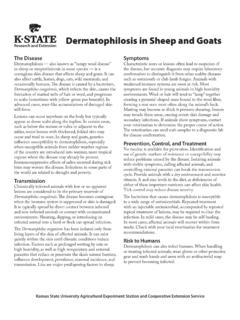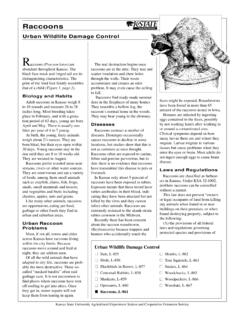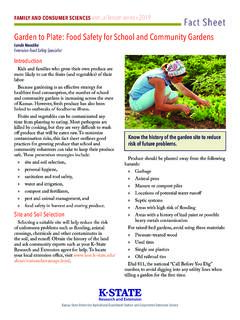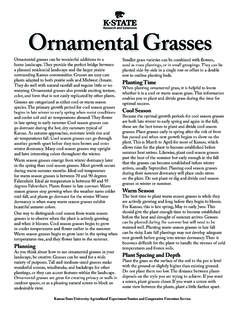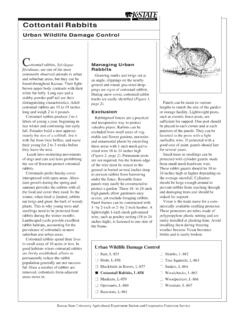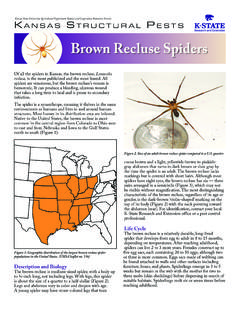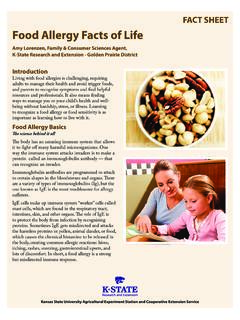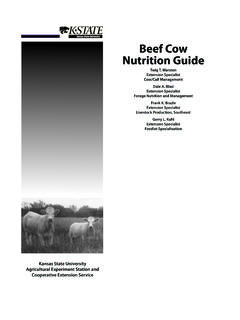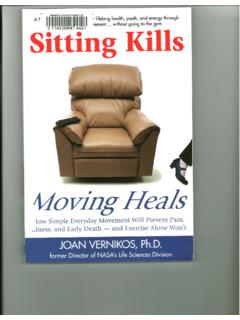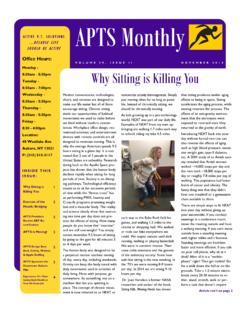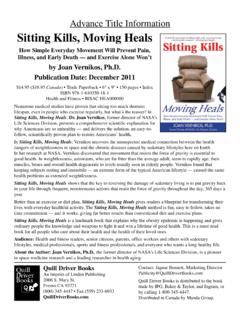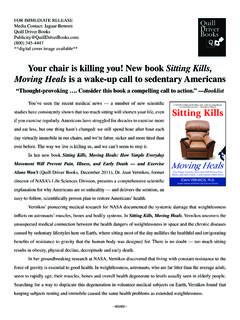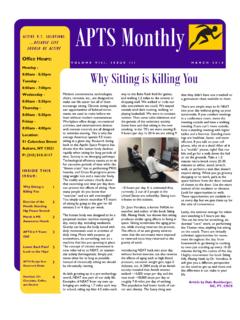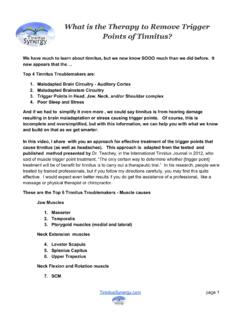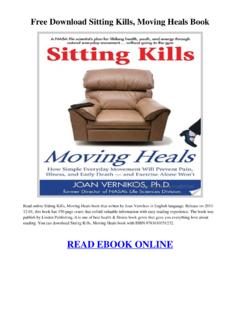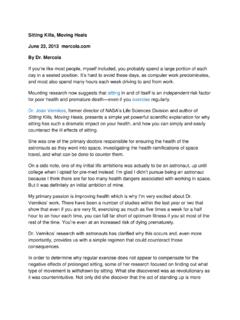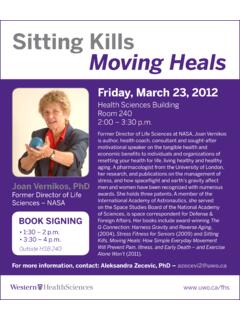Transcription of ² § ¨§¬®¦ «¬ ¢ § ¬ annual lesson series » Leader’s Move ...
1 Leader s GuideKansas State University Agricultural Experiment Station and Cooperative Extension Servicefamily and consumer sciences annual lesson series 2018 Intended audiences: Adults and older adults who may have to spend most of their day seated because of job requirements, lifestyle, or physical limitations; Family and Community Education groups; Extension Family and Consumer Science leaders; and educators and their Program PreparationBefore the lesson , consider these teaching suggestions: Read the Move More, Sit Less fact sheet (MF3376) and this leader s guide. Research some of the websites or books mentioned in the references section of the fact sheet and leader s guide.
2 Prepare enough copies of Move More, Sit Less fact sheet (MF3376) for each participant. Bring pencils for evaluation and discussion More, Sit LessIntroduction:Think about your day today. How did you spend your time? Did you drive, walk, or ride your bike to work or school or other activities? When you were at work or at school, what did you do? Were you seated at a desk with a computer or other office device, or listening to an instructor while sitting in the classroom? Maybe you watched television, read, slept, or played video games all day. Or, maybe you spent your time moving and engaged in a variety of physical are, if you are like most Kansans, you got in your car, drove to work or to run errands ( sitting ), were at your work station ( sitting ) most of the day, only getting up to use the restroom or to do some other task.
3 Then you drove home, sat in your chair or recliner and watched television, spent time online, or read until bedtime. Between work and leisure, the average Kansan spends more than 13 hours each day (more than 50 percent) in a low-energy activity in other words, sitting . The fact sheet (MF3376) focuses on why moving more is so important for our health and well-being and easy ways to add more movement each :After completing this lesson , participants will:1. Understand what sedentary behaviors are and why they are so Learn why sedentary behaviors are so harmful to overall health and Understand NEAT and how it can make a big difference in health.
4 4. Learn how to reduce sedentary behaviors and add in more physical activity to each E. Lorenzen, Extension Agent, Golden Prairie District, K-State Research and Extension 2 K-State Research and ExtensionMove More, Sit Less Discuss the suggestions for moving more at work and at home with the participants, along with the discussion questions in the leader s guide. If possible, bring a pedometer or fitness tracker to show how these devices can track daily physical metabolic rate: The rate at which the body uses energy while at rest to keep vital functions going, such as breathing and keeping energy sedentary activities: Any activity that does not expend any energy beyond your basal metabolic rate sitting , : The chemical processes that occur within a living organism in order to maintain activity thermogenesis (NEAT): The energy expended for everything we do that is not sleeping, eating, or sports-like exercise.
5 It includes the energy expended walking to work, typing, performing yard work, undertaking agricultural tasks, and effect of food: The increase in metabolic rate after ingestion of a questions for Move More, Sit Less:1. Generally, how much time do you spend sitting ? (Reading, watching TV, doing crafts, working, driving, talking on the phone, texting, computer work, writing, etc.)2. Think about your daily behavior and routine before today. Do you normally stand and stretch every 30 minutes? Move a little every 60 minutes?3. Can you walk or ride a bike, instead of drive, to any of your activities or errands?
6 4. Can you stand or move while doing any of these activities?5. Think about the suggestions in this lesson for moving more at work and at home. Are you willing to try any of these? Which ones?6. Can you think of other ways you can move more and sit less in your life?References: American Association of Psychological Science. More Bad News about sitting : It May Harm Workers Mental Health, Accessed on January 4, College of Sports Medicine. Reducing Sedentary Behaviors: Sit Less and Move More, , accessed December 10, TH Chan School of Public Health. Obesity Prevention Source: Physical Activity Can Help Control Weight Accessed January 26, , James A.
7 MD, PhD; Selene Yaeger. Move A Little, Lose A Lot. 2009 Three Rivers Press, New York. ISBN 978-0-0307-40855-6 Merriam-Webster Dictionary, Accessed January 26, Heart Foundation of Australia, Move More Sit Less initiative. Be Active Every Day, Tips to be more active, sit less and live longer and Am I Active Enough? Accessed on Jan. 25, Institute on Aging, Go4 Life, Work Out at Work, Accessed on January 9, Today, Andrews, Linda Wasmer. What sitting Does to Your Psy-che, Accessed on Jan. 6, Non-exercise activity thermogenesis (NEAT) Accessed January 26, , Michelle ; How the Simple Science of Motivation Can Bring You a Lifetime of Fitness, 2015 AMACON Books, New York.
8 , Larry. Scared Sitless The Office Fitness Book, 2015 Elless Media LLC, Seattle, WA. ISBN-13 , Joan , sitting Kills moving Heals, 2011 Quill Driver Books, Fresno, CA. ISBN Life Balance, Mental Health America, Accessed March 8, State University Agricultural Experiment Station and Cooperative Extension Servicefamily and consumer sciences annual lesson series 2018 EvaluationWe appreciate your opinions! Please help us make our programs better by taking about 5 minutes to answer the following questions. Your participation is completely voluntary, and you may skip answering one or more questions if you perfer.
9 The information that you share will be held in the strictest confidence. We will summarize the data, in order to evaluate our program. We greatly value your participation. Thank you!1. Before today, did you routinely stand or move every hour during your day while you were awake? o Yes o NoScale: 1=no commitment and 5=complete commitment2. After today, how committed are you to moving more throughout your day by standing or moving every hour? 1 2 3 4 5 3. After today, how confident do you feel that you will be able to change your activity level?
10 1 2 3 4 54. Which activity/activities suggested today will you try?5. Do you take the stairs whenever you can? 6. What activities could you do besides watching television in your leisure time?Please rate from 1 to 5, with 1 = least important and 5 = most important:7. How important is it to you to change the way you spend your leisure/work time? 1 2 3 4 58. How important is good health to you?
